Assessment of Sampling Effects on Various Satellite-Derived Integrated Water Vapor Datasets Using GPS Measurements in Germany as Reference
Abstract
1. Introduction
- How well do individual IWV satellite measurements agree with local measurements over Germany?
- To which degree does temporal averaging provide robust IWV climatologies?
- What is the impact of temporal as well as satellite retrieval-specific sampling on aggregated IWV data as well as IWV frequency distributions?
2. Data
2.1. GPS
2.2. IASI
2.3. MIRS
2.4. MODIS
2.5. MODIS-FUB
2.6. SEVIRI Cloud Coverage
3. Matching Satellite and GPS IWV Measurements
4. Results
4.1. Direct Comparisons of Satellite and GPS IWV Values
4.2. Comparisons of Satellite and GPS IWV Monthly Means
4.3. Impact of Temporal and Satellite Retrieval-Specific Sampling on IWV Aggregations and Distributions
5. Discussion
Author Contributions
Funding
Acknowledgments
Conflicts of Interest
Abbreviations
| FUB | Freie Universität Berlin |
| GNSS | Global Navigation Satellite Systems |
| GPS | Global Positioning System |
| IASI | Infrared Atmospheric Sounding Interferometer |
| IWV | Integrated Water Vapor |
| MIRS | Microwave Integrated Retrieval System |
| MODIS | Moderate Resolution Imaging Spectroradiometer |
| MSG | Meteosat Second Generation |
| NIR | Near-Infrared |
| RMSE | Root Mean Square Error |
| SEVIRI | Spinning Enhanced Visible and Infrared Imager |
| STD | Standard Deviation |
References
- Kiehl, J.T.; Trenberth, K.E. Earth’s annual global mean energy budget. Bull. Am. Meteorol. Soc. 1997, 78, 197–208. [Google Scholar] [CrossRef]
- Bengtsson, L. The global atmospheric water cycle. Environ. Res. Lett. 2010, 5, 025202. [Google Scholar] [CrossRef]
- Held, I.M.; Soden, B.J. Water vapor feedback and global warming. Annu. Rev. Energy Environ. 2000, 25, 441–475. [Google Scholar] [CrossRef]
- Lacis, A.A.; Schmidt, G.A.; Rind, D.; Ruedy, R.A. Atmospheric CO2: Principal control knob governing Earth’s temperature. Science 2010, 330, 356–359. [Google Scholar] [CrossRef]
- Hegerl, G.C.; Black, E.; Allan, R.P.; Ingram, W.J.; Polson, D.; Trenberth, K.E.; Chadwick, R.S.; Arkin, P.A.; Sarojini, B.B.; Becker, A.; et al. Challenges in quantifying changes in the global water cycle. Bull. Am. Meteorol. Soc. 2019, 100. [Google Scholar] [CrossRef]
- Bony, S.; Duvel, J.P.; Le Trent, H. Observed dependence of the water vapor and clear-sky greenhouse effect on sea surface temperature: Comparison with climate warming experiments. Clim. Dyn. 1995, 11, 307–320. [Google Scholar] [CrossRef]
- Jiang, J.H.; Su, H.; Zhai, C.; Perun, V.S.; Del Genio, A.; Nazarenko, L.S.; Donner, L.J.; Horowitz, L.; Seman, C.; Cole, J.; et al. Evaluation of cloud and water vapor simulations in CMIP5 climate models using NASA “A-Train” satellite observations. J. Geophys. Res. Atmos. 2012, 117. [Google Scholar] [CrossRef]
- Stevens, B.; Brogniez, H.; Kiemle, C.; Lacour, J.L.; Crevoisier, C.; Kiliani, J. Structure and dynamical influence of water vapor in the lower tropical troposphere. In Shallow Clouds, Water Vapor, Circulation, and Climate Sensitivity; Springer: Berlin, Germany, 2017; pp. 199–225. [Google Scholar]
- Durre, I.; Vose, R.S.; Wuertz, D.B. Overview of the integrated global radiosonde archive. J. Clim. 2006, 19, 53–68. [Google Scholar] [CrossRef]
- Mears, C.A.; Smith, D.K.; Ricciardulli, L.; Wang, J.; Huelsing, H.; Wentz, F.J. Construction and uncertainty estimation of a satellite-derived total precipitable water data record over the world’s oceans. Earth Space Sci. 2018, 5, 197–210. [Google Scholar] [CrossRef]
- Rinke, A.; Segger, B.; Crewell, S.; Maturilli, M.; Naakka, T.; Nygård, T.; Vihma, T.; Alshawaf, F.; Dick, G.; Wickert, J.; et al. Trends of Vertically Integrated Water Vapor over the Arctic during 1979–2016: Consistent Moistening All Over? J. Clim. 2019, 32, 6097–6116. [Google Scholar] [CrossRef]
- Chahine, M.T. GEWEX: The global energy and water cycle experiment. Eos Trans. Am. Geophys. Union 1992, 73, 9–14. [Google Scholar] [CrossRef]
- Schröder, M.; Lockhoff, M.; Shi, L.; August, T.; Bennartz, R.; Borbas, E.; Brogniez, H.; Calbet, X.; Crewell, S.; Eikenberg, S.; et al. GEWEX Water Vapor Assessment (G-VAP); WCRP Report 16/2017; World Climate Research Programme (WCRP): Geneva, Switzerland, 2017. [Google Scholar]
- Carbajal Henken, C.; Diedrich, H.; Preusker, R.; Fischer, J. MERIS full-resolution total column water vapor: Observing horizontal convective rolls. Geophys. Res. Lett. 2015, 42, 10–074. [Google Scholar] [CrossRef]
- Sohn, B.J.; Bennartz, R. Contribution of water vapor to observational estimates of longwave cloud radiative forcing. J. Geophys. Res. Atmos. 2008, 113. [Google Scholar] [CrossRef]
- Roman, J.; Knuteson, R.; August, T.; Hultberg, T.; Ackerman, S.; Revercomb, H. A global assessment of NASA AIRS v6 and EUMETSAT IASI v6 precipitable water vapor using ground-based GPS SuomiNet stations. J. Geophys. Res. Atmos. 2016, 121, 8925–8948. [Google Scholar] [CrossRef]
- Diedrich, H.; Wittchen, F.; Preusker, R.; Fischer, J. Representativeness of total column water vapour retrievals from instruments on polar orbiting satellites. Atmos. Chem. Phys. 2016, 16, 8331–8339. [Google Scholar] [CrossRef]
- Steinke, S.; Eikenberg, S.; Löhnert, U.; Dick, G.; Klocke, D.; Di Girolamo, P.; Crewell, S. Assessment of small-scale integrated water vapour variability during HOPE. Atmos. Chem. Phys. 2015, 15, 2675–2692. [Google Scholar] [CrossRef]
- Macke, A.; Seifert, P.; Baars, H.; Barthlott, C.; Beekmans, C.; Behrendt, A.; Bohn, B.; Brueck, M.; Bühl, J.; Crewell, S.; et al. The HD (CP) 2 Observational Prototype Experiment (HOPE)—An overview. Atmos. Chem. Phys. 2017, 17, 4887–4914. [Google Scholar] [CrossRef]
- Schmetz, J.; Pili, P.; Tjemkes, S.; Just, D.; Kerkmann, J.; Rota, S.; Ratier, A. An introduction to Meteosat second generation (MSG). Bull. Am. Meteorol. Soc. 2002, 83, 977–992. [Google Scholar] [CrossRef]
- Gendt, G.; Dick, G.; Reigber, C.; Tomassini, M.; Liu, Y.; Ramatschi, M. Near real time GPS water vapor monitoring for numerical weather prediction in Germany. J. Meteorol. Soc. 2004, 82, 361–370. [Google Scholar] [CrossRef]
- August, T.; Klaes, D.; Schlüssel, P.; Hultberg, T.; Crapeau, M.; Arriaga, A.; O’Carroll, A.; Coppens, D.; Munro, R.; Calbet, X. IASI on Metop-A: Operational Level 2 retrievals after five years in orbit. J. Quant. Spectrosc. Radiat. Transf. 2012, 113, 1340–1371. [Google Scholar] [CrossRef]
- Boukabara, S.A.; Garrett, K.; Chen, W.; Iturbide-Sanchez, F.; Grassotti, C.; Kongoli, C.; Chen, R.; Liu, Q.; Yan, B.; Weng, F.; et al. MiRS: An all-weather 1DVAR satellite data assimilation and retrieval system. IEEE Trans. Geosci. Remote Sens. 2011, 49, 3249–3272. [Google Scholar] [CrossRef]
- Gao, B.; Kaufman, Y.J. Water vapor retrievals using moderate resolution imaging spectroradiometer (MODIS) near-infrared channels. J. Geophys. Res. Atmos. 2003, 108, D13. [Google Scholar] [CrossRef]
- Diedrich, H.; Preusker, R.; Lindstrot, R.; Fischer, J. Retrieval of daytime total columnar water vapour from MODIS measurements over land surfaces. Atmos. Meas. Tech. 2015, 8, 823–836. [Google Scholar] [CrossRef][Green Version]
- Fang, P.; Bevis, M.; Bock, Y.; Gutman, S.; Wolfe, D. GPS meteorology: Reducing systematic errors in geodetic estimates for zenith delay. Geophys. Res. Lett. 1998, 25, 3583–3586. [Google Scholar] [CrossRef]
- Steinke, S. Variability of Integraded Water Vapor: An Assessment on Various Scales with Observations and Model Simulations over Germany. Ph.D. Thesis, University of Cologne, Cologne, Germany, 2017. [Google Scholar]
- Ning, T.; Wang, J.; Elgered, G.; Dick, G.; Wickert, J.; Bradke, M.; Sommer, M. The uncertainty of the atmospheric integrated water vapour estimated from GNSS observations. Atmos. Meas. Tech. 2016, 9, 79–92. [Google Scholar] [CrossRef]
- Zhang, D.; Guo, J.; Chen, M.; Shi, J.; Zhou, L. Quantitative assessment of meteorological and tropospheric Zenith Hydrostatic Delay models. Adv. Space Res. 2016, 58, 1033–1043. [Google Scholar] [CrossRef]
- Dick, G.; Gendt, G.; Reigber, C. First experience with near real-time water vapor estimation in a German GPS network. J. Atmos. Sol.-Terr. Phys. 2001, 63, 1295–1304. [Google Scholar] [CrossRef]
- NOAA Center for Satellite Applications and Research (STAR). Available online: https://www.star.nesdis.noaa.gov/mirs/downloaddap.php (accessed on 10 January 2020).
- NASA Level-1 and Atmosphere Archive & Distribution System (LAADS) Distributed Active Archive Center (DAAC). Available online: https://ladsweb.nascom.nasa.gov/ (accessed on 10 January 2020).
- Lindstrot, R.; Preusker, R.; Diedrich, H.; Doppler, L.; Bennartz, R.; Fischer, J. 1D-Var retrieval of daytime total columnar water vapour from MERIS measurements. Atmos. Meas. Tech. 2012, 5, 631. [Google Scholar] [CrossRef]
- Reuter, M.; Thomas, W.; Albert, P.; Lockhoff, M.; Weber, R.; Karlsson, K.G.; Fischer, J. The CM-SAF and FUB cloud detection schemes for SEVIRI: Validation with synoptic data and initial comparison with MODIS and CALIPSO. J. Appl. Meteorol. Climatol. 2009, 48, 301–316. [Google Scholar] [CrossRef]
- Rathke, C.; Fischer, J. Retrieval of cloud microphysical properties from thermal infrared observations by a fast iterative radiance fitting method. J. Atmos. Ocean. Technol. 2000, 17, 1509–1524. [Google Scholar] [CrossRef]
- Wahl, S.; Bollmeyer, C.; Crewell, S.; Figura, C.; Friederichs, P.; Hense, A.; Keller, J.D.; Ohlwein, C. A novel convective-scale regional reanalysis COSMO-REA2: Improving the representation of precipitation. Meteorol. Z. 2017, 26, 345–361. [Google Scholar] [CrossRef]
- Steinke, S.; Wahl, S.; Crewell, S. Benefit of high resolution COSMO reanalysis: The diurnal cycle of column-integrated water vapor over Germany. Meteorol. Z. 2019, 28, 165–177. [Google Scholar] [CrossRef]
- Farr, T.G.; Kobrick, M. Shuttle Radar Topography Mission produces a wealth of data. Eos Trans. Am. Geophys. Union 2000, 81, 583–585. [Google Scholar] [CrossRef]
- Dai, A.; Wang, J.; Ware, R.H.; Van Hove, T. Diurnal variation in water vapor over North America and its implications for sampling errors in radiosonde humidity. J. Geophys. Res. Atmos. 2002, 107. [Google Scholar] [CrossRef]
- Donlon, C.; Berruti, B.; Buongiorno, A.; Ferreira, M.H.; Féménias, P.; Frerick, J.; Goryl, P.; Klein, U.; Laur, H.; Mavrocordatos, C.; et al. The global monitoring for environment and security (GMES) sentinel-3 mission. Remote Sens. Environ. 2012, 120, 37–57. [Google Scholar] [CrossRef]
- Aguirre, M.; Berruti, B.; Bezy, J.L.; Drinkwater, M.; Heliere, F.; Klein, U.; Mavrocordatos, C.; Silvestrin, P.; Greco, B.; Benveniste, J. Sentinel-3-the ocean and medium-resolution land mission for GMES operational services. ESA Bull. 2007, 131, 24–29. [Google Scholar]
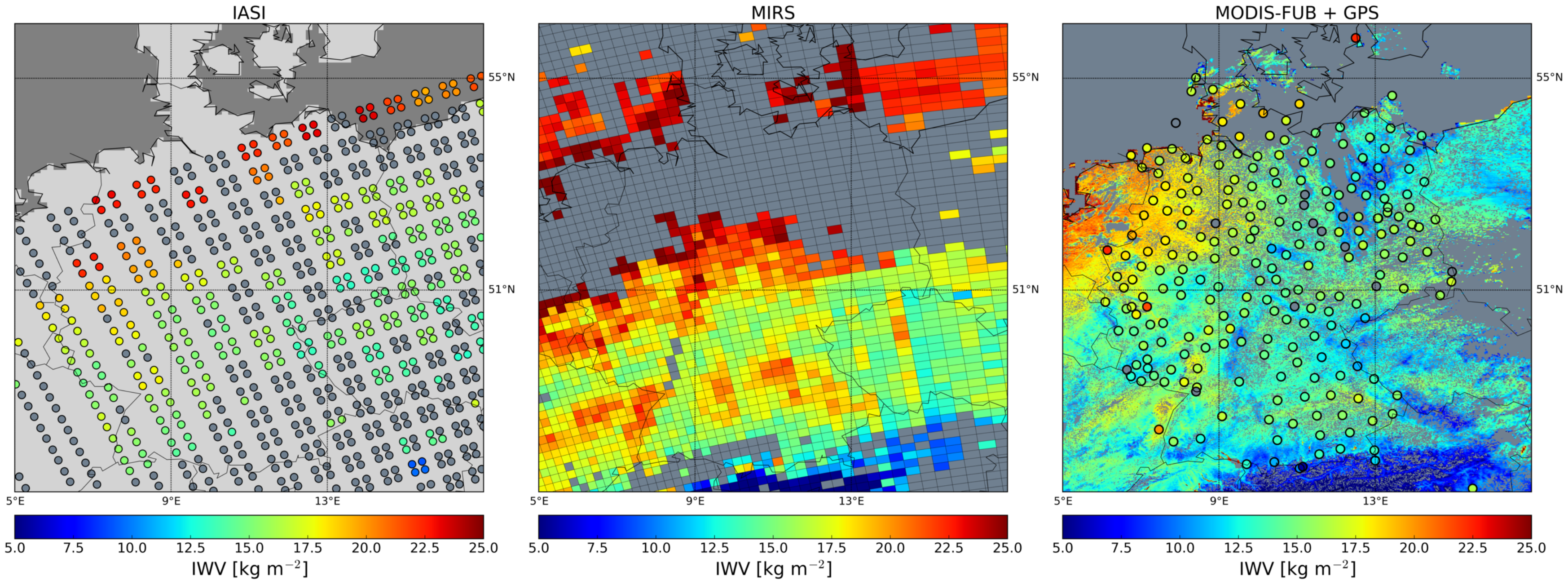

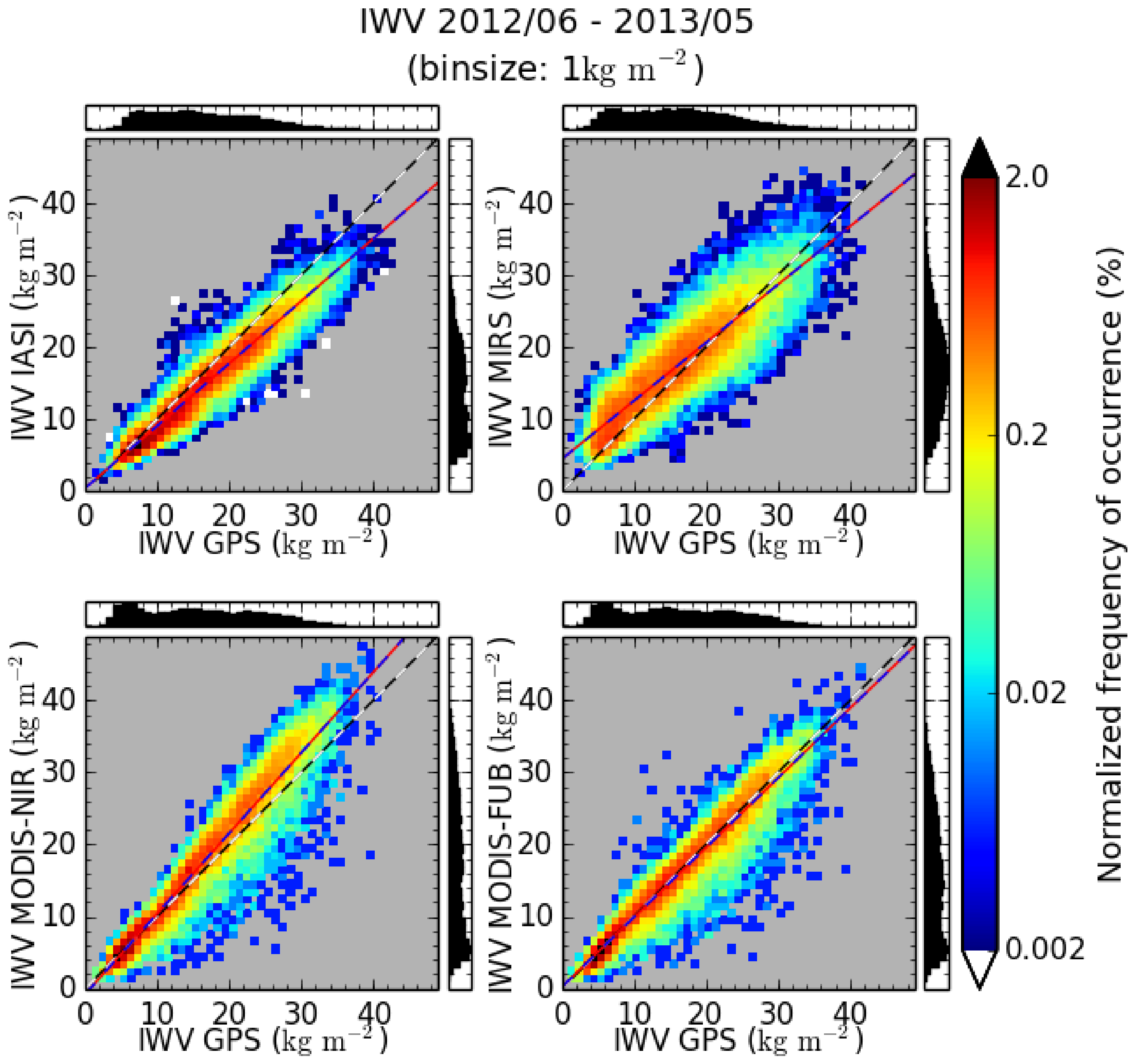
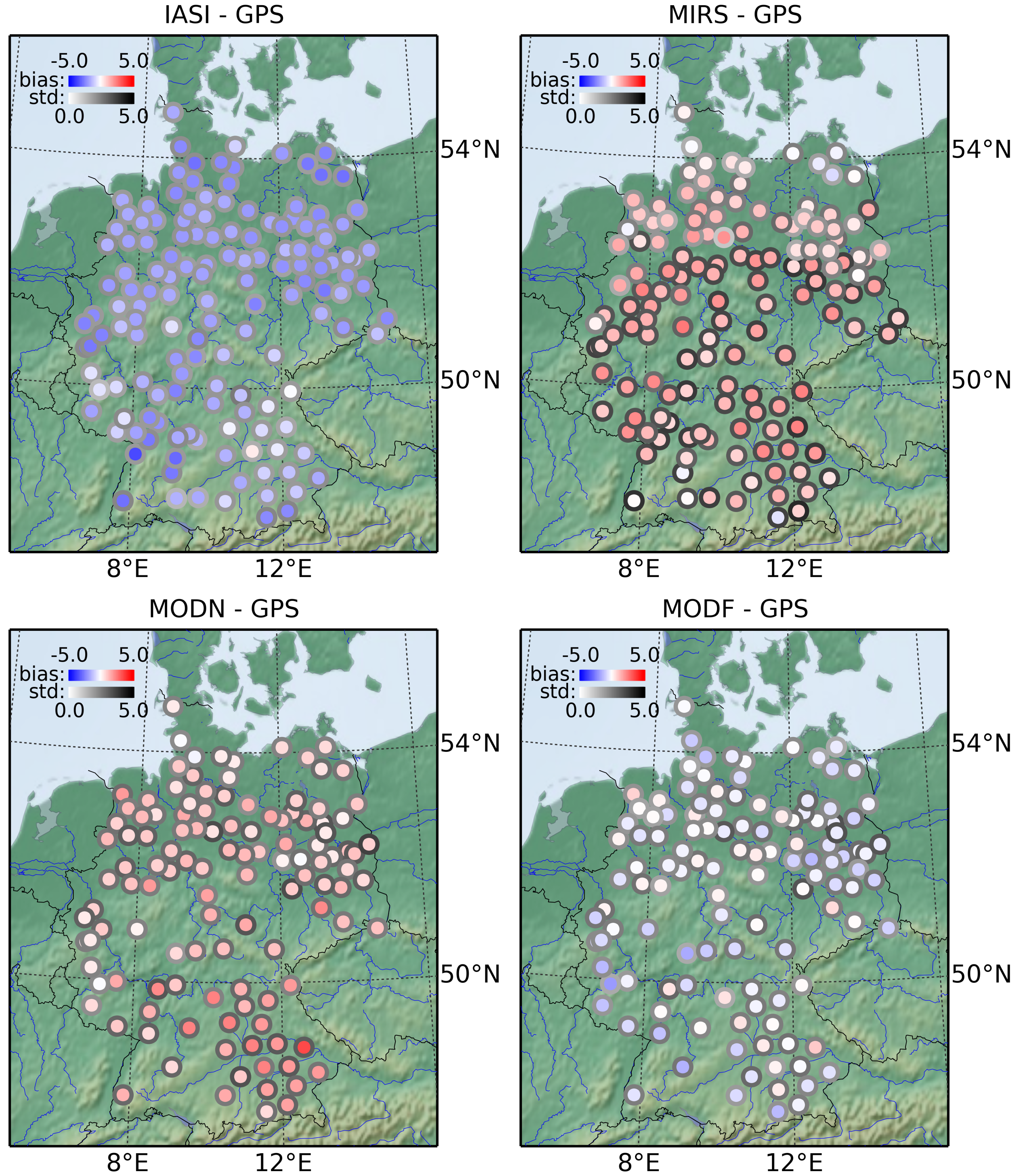
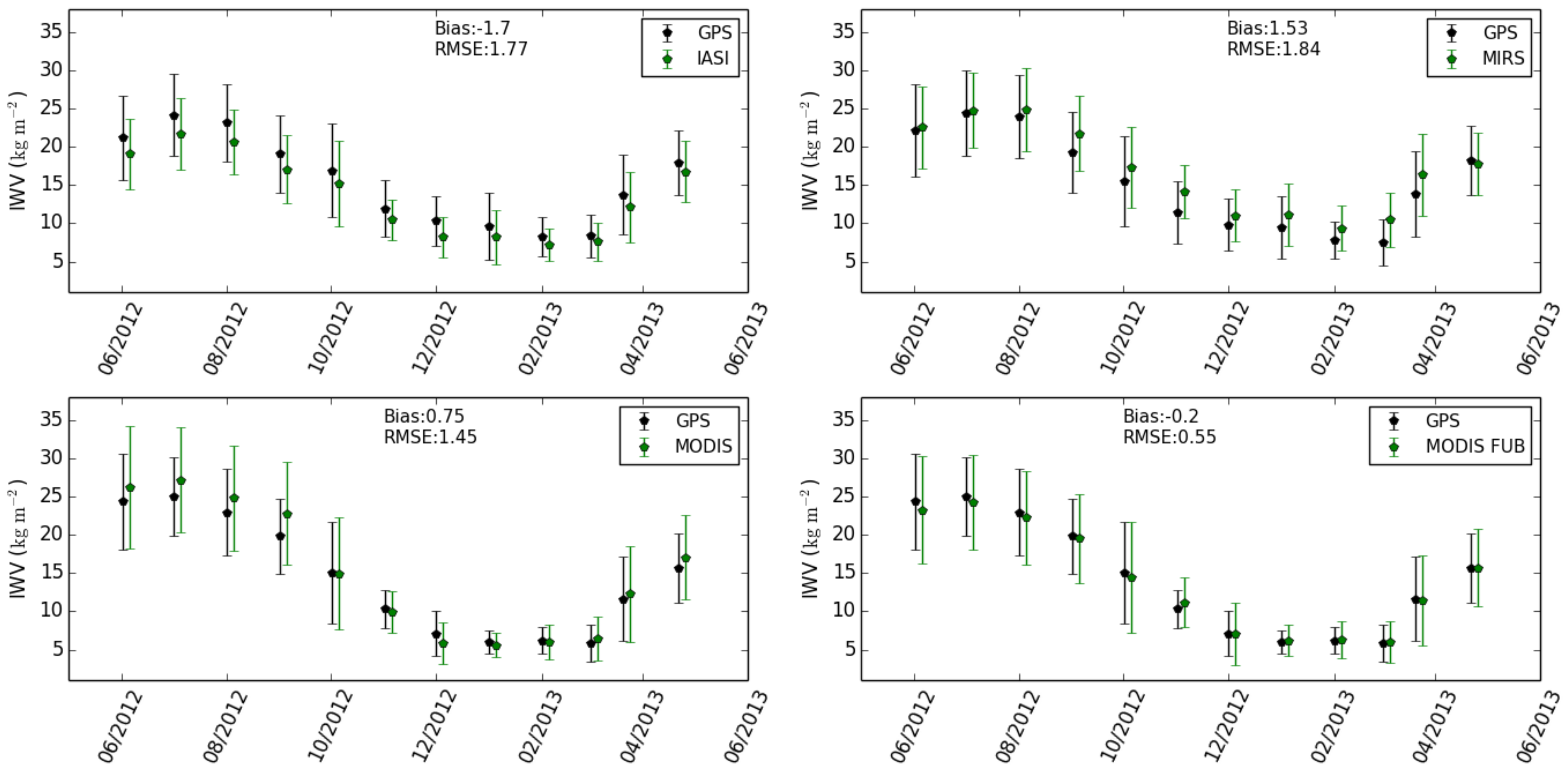

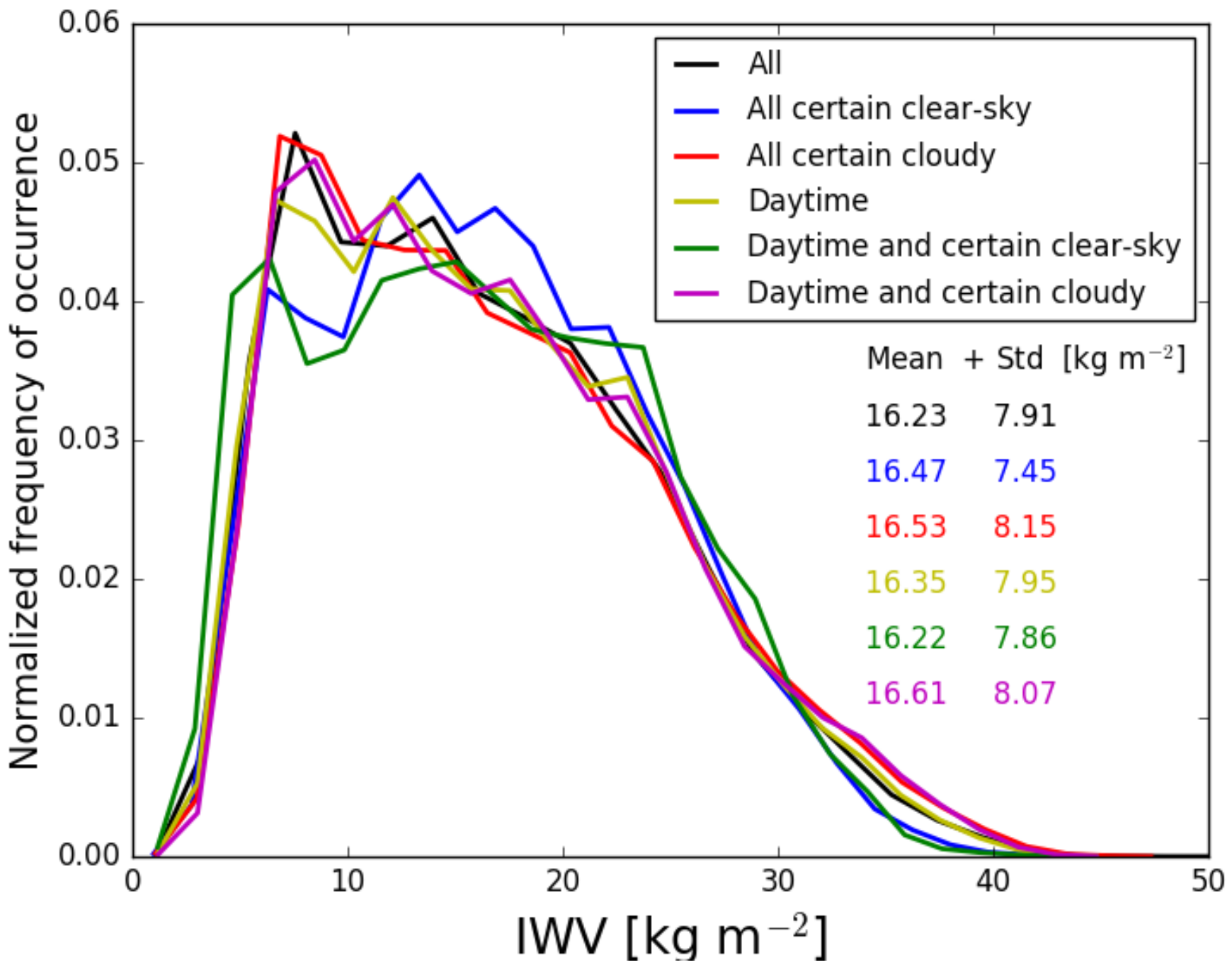
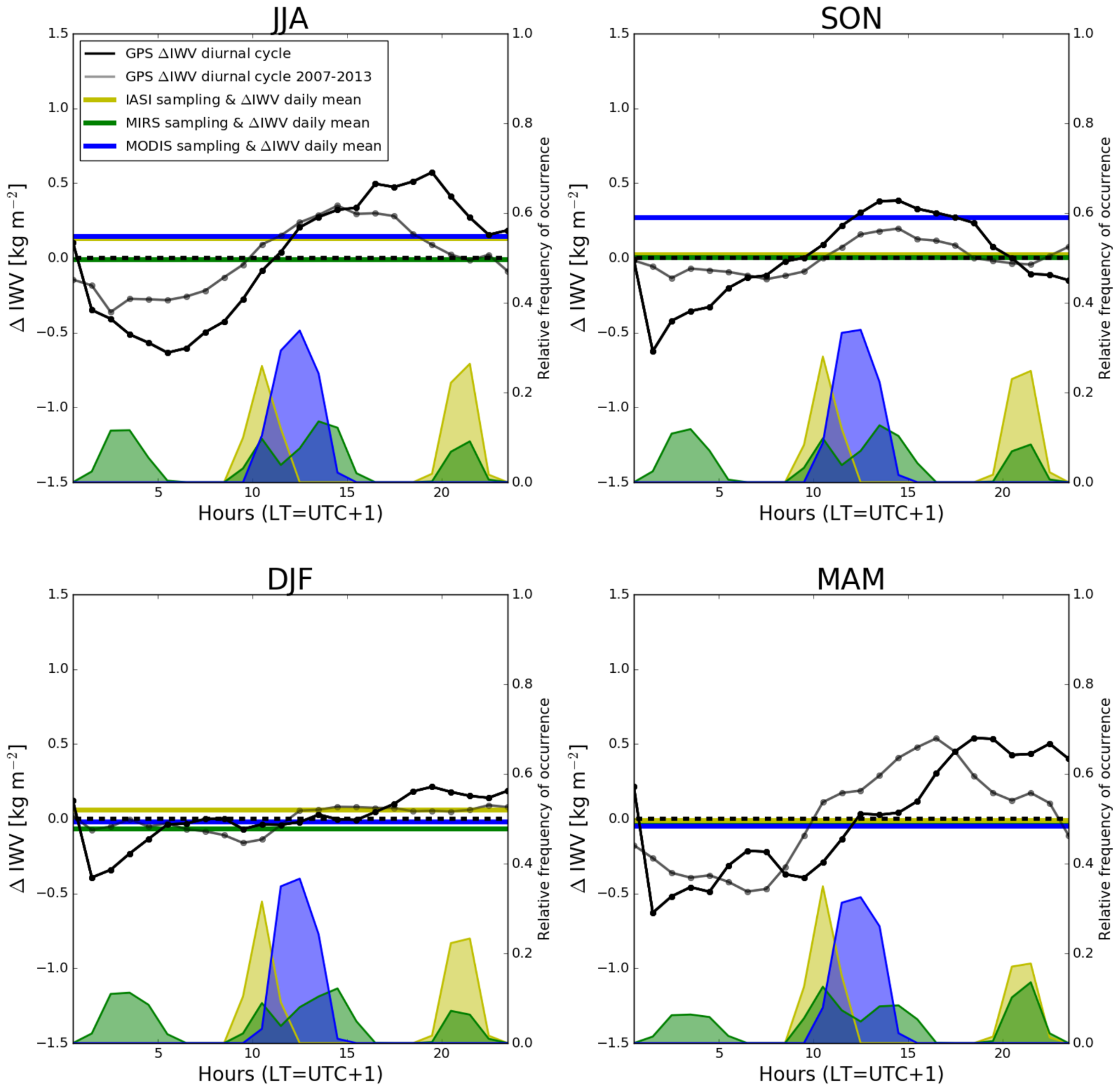
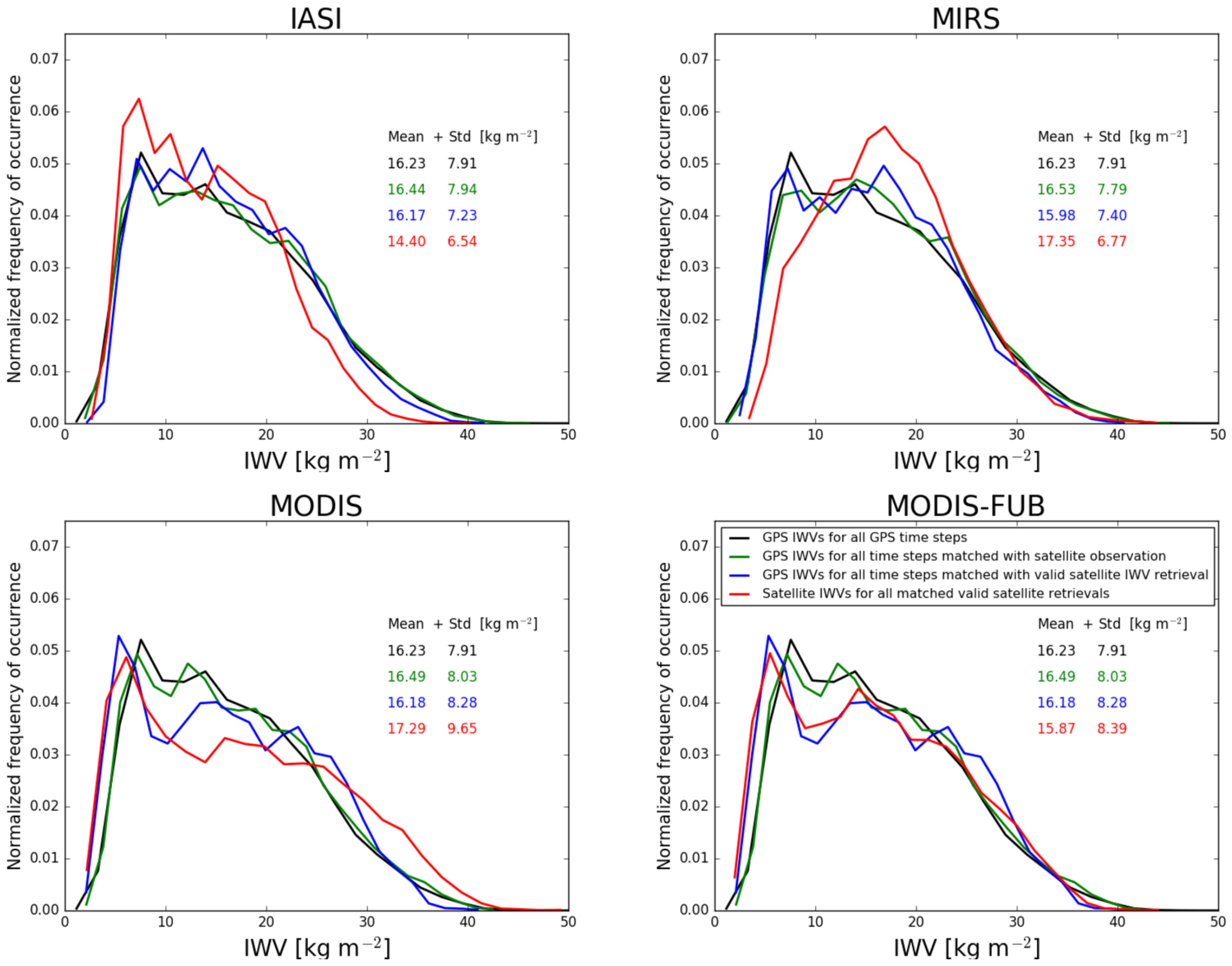
| Instrument | Spatial Resolution | Temporal Resolution | Retrieval Limitations | Reference |
|---|---|---|---|---|
| GPS | nearly 300 stations in Germany | 15 min | Gendt et al. [21] | |
| IASI | 12 km | 2 times per day | clear sky | August et al. [22] |
| MIRS | 16 km | 4 times per day | Boukabara et al. [23] | |
| MODIS * | 1 km | 2 times per day | daytime, clear sky, land surfaces ** | Gao and Kaufman [24] |
| MODIS-FUB | 1 km | 2 times per day | daytime, clear sky, land surfaces | Diedrich et al. [25] |
| Instrument | N | Bias | RMSE | Std | Mean (x) | Mean (y) | R | Slope | Intercept |
|---|---|---|---|---|---|---|---|---|---|
| IASI | 88336 | −1.77 ± 0.006 | 2.74 | 2.09 | 16.17 | 14.40 | 0.959 | 0.866 ± 0.001 | 0.387 ± 0.015 |
| MIRS | 41948 | 1.36 ± 0.016 | 3.77 | 3.50 | 15.98 | 17.36 | 0.881 | 0.807 ± 0.002 | 4.453 ± 0.037 |
| MODIS | 17438 | 1.11 ± 0.021 | 3.11 | 2.91 | 16.18 | 17.28 | 0.959 | 1.117 ± 0.003 | −0.781 ± 0.046 |
| MODIS-FUB | 17437 | −0.31 ± 0.019 | 2.52 | 2.50 | 16.18 | 15.87 | 0.955 | 0.967 ± 0.002 | 0.226 ± 0.041 |
| IWV | 10% | 50% | 90% | |||||
|---|---|---|---|---|---|---|---|---|
| Certain clear sky | 0.24 | 0.10 | 0.70 | −0.50 | −1.83 (33.7%) | −1.24 (33.5%) | −0.89 (13.7%) | −1.19 (19.1%) |
| Daytime | 0.12 | −0.10 | 0.20 | 0.20 | 0.15 (25.2%) | 0.05 (25.0%) | 0.09 (24.1%) | −0.14 (25.7%) |
| Daytime & certain clear sky | −0.01 | −0.80 | 0.50 | −0.20 | −1.20 (31.0%) | −1.31 (35.5%) | 0.25 (11.5%) | −3.06 (22.0%) |
| IWV | 10% | 50% | 90% | |||||
|---|---|---|---|---|---|---|---|---|
| GPS with IASI sampling | −0.05 | 0.50 | 0.00 | −1.10 | −1.28 (28.8%) | −0.90 (29.7%) | −0.70 (23.1%) | 0.45 (18.4%) |
| IASI Bias | −1.83 | −0.28 | −1.48 | −3.79 | −3.66 | −2.62 | −2.25 | −0.74 |
| GPS with MIRS sampling | −0.25 | −0.10 | 0.30 | −1.11 | −0.83 (24.0%) | −1.29 (24.6%) | −1.07 (18.4%) | 0.79 (33.0%) |
| MIRS Bias | 1.12 | 1.90 | 1.70 | −0.81 | −0.26 | 1.01 | 0.45 | 2.05 |
| GPS with MODIS sampling | −0.05 | −1.20 | 0.30 | 0.49 | −0.41 (31.5%) | −0.93 (32.3%) | −3.44 (7.9%) | −3.24 (28.3%) |
| MODIS Bias | 1.06 | −1.35 | 1.20 | 3.85 | 1.53 | 0.07 | −4.23 | −2.40 |
| MODIS-FUB Bias | −0.36 | −1.46 | −0.11 | 0.49 | −1.23 | −1.11 | −3.36 | −3.24 |
© 2020 by the authors. Licensee MDPI, Basel, Switzerland. This article is an open access article distributed under the terms and conditions of the Creative Commons Attribution (CC BY) license (http://creativecommons.org/licenses/by/4.0/).
Share and Cite
Carbajal Henken, C.; Dirks, L.; Steinke, S.; Diedrich, H.; August, T.; Crewell, S. Assessment of Sampling Effects on Various Satellite-Derived Integrated Water Vapor Datasets Using GPS Measurements in Germany as Reference. Remote Sens. 2020, 12, 1170. https://doi.org/10.3390/rs12071170
Carbajal Henken C, Dirks L, Steinke S, Diedrich H, August T, Crewell S. Assessment of Sampling Effects on Various Satellite-Derived Integrated Water Vapor Datasets Using GPS Measurements in Germany as Reference. Remote Sensing. 2020; 12(7):1170. https://doi.org/10.3390/rs12071170
Chicago/Turabian StyleCarbajal Henken, Cintia, Lisa Dirks, Sandra Steinke, Hannes Diedrich, Thomas August, and Susanne Crewell. 2020. "Assessment of Sampling Effects on Various Satellite-Derived Integrated Water Vapor Datasets Using GPS Measurements in Germany as Reference" Remote Sensing 12, no. 7: 1170. https://doi.org/10.3390/rs12071170
APA StyleCarbajal Henken, C., Dirks, L., Steinke, S., Diedrich, H., August, T., & Crewell, S. (2020). Assessment of Sampling Effects on Various Satellite-Derived Integrated Water Vapor Datasets Using GPS Measurements in Germany as Reference. Remote Sensing, 12(7), 1170. https://doi.org/10.3390/rs12071170





